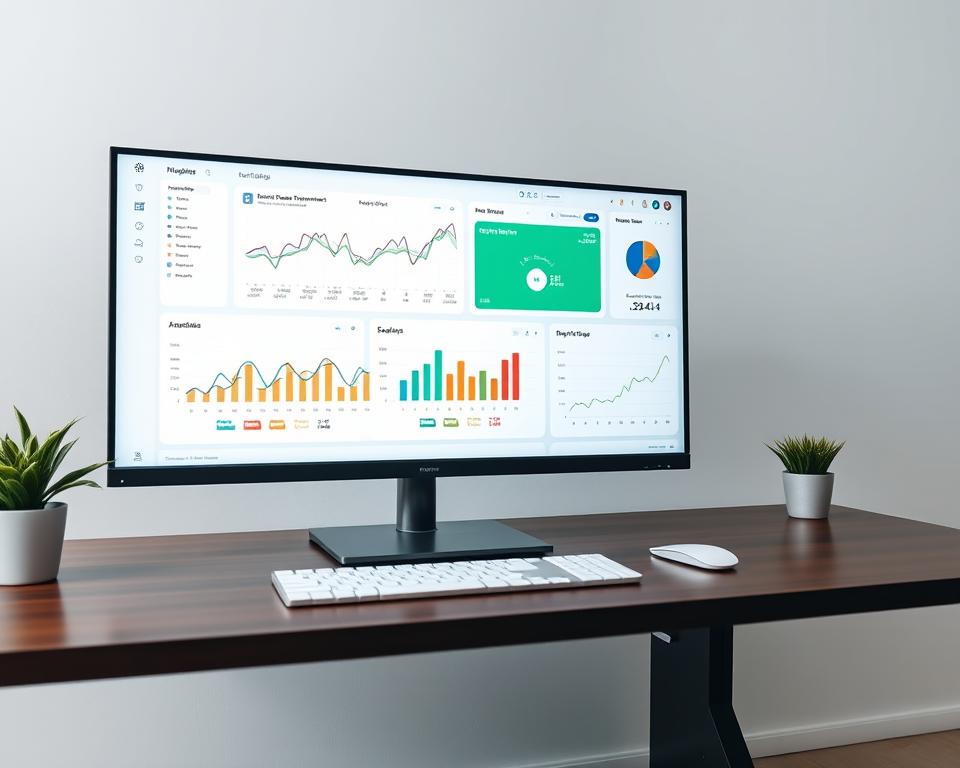Anúncios
You will learn how to measure performance results in a practical way that links daily work to your strategy without extra complexity.
Curious: what if most of your data never guides a single decision?
Only about 32 percent of collected information gets acted on. That gap keeps many businesses from learning fast. This section shows a low-friction approach you can adapt to your organization.
We blend objective numbers like revenue with subjective indicators such as engagement so you can see profitability and people together. You get clear steps to pick meaningful metrics, set baselines, and run small tests.
Anúncios
Expect guidance, not guarantees: use lightweight diagnostic controls—scorecards, project checks, and simple HR signals—to keep managers informed and preserve psychological safety.
Start small, learn quickly, and scale what works for your business and stage.
Introduction: Why you should measure performance results now
Now is the moment to turn everyday data into decisions that move your business forward. With markets shifting quickly and resources tight, a simple, repeatable approach helps you find high-value opportunities without heavy overhead.
Anúncios
Only about 32 percent of available information gets acted on in many organizations, so most signals sit unused. You can change that by building short routines that link facts to near-term choices: where to invest time, what to pause, and which small tests to run.
Blend objective figures like revenue trends with subjective signals such as employee engagement. When applied with fairness and trust, engagement has been tied to profitability gains up to 23 percent.
This is guidance, not a guarantee: use metrics as creative constraints. Start with a few high-signal indicators aligned to your strategy, run weekly checks for leading signs, and hold monthly reviews to learn and iterate. For a practical framework on what good looks like, see this performance guide.
- Focus on measures teams can influence.
- Avoid vanity numbers that add noise.
- Keep cadence light so you can act fast and learn faster.
Core principles for performance measurement that balances finance, quality, and people
A durable approach links what shows up on the P&L with customer trust and team capability. That mix helps your company create lasting value without sacrificing quality for short-term gain.
Balance finance and people. Pick a small set of measures that covers financials, customer signals, internal process, and learning. Keep each indicator clear so managers and employees know what it tracks and why it matters.
Blend leading and lagging indicators
Use lagging financial metrics along with leading signs like customer feedback, defect rates, and skill development. This way your strategy shows up both in the P&L and in operational stability.
Capture intangible value with a scorecard
A balanced scorecard helps include brand loyalty, relationships, and R&D capability alongside cash flows. It is a practical frame, not the only way to design measurement.
Standardize with diagnostic controls
Adopt scorecards, project checks, HR signals, and cost accounting so teams compare like with like. Document owners for each metric and link each one to a clear strategic question.
- Treat quality as non-negotiable; avoid trading it for short-term gains.
- Apply subjective indicators consistently to protect trust and reduce bias.
- Hold reviews that ask, “what did we learn and what will we try next?”
“Never sacrifice quality goals for financial goals.”
How to measure performance results step by step
Start with a short plan that turns strategy into one clear outcome each team can own. That one-page objective should state the outcome, who benefits, and a plain-language definition so every person understands the goal.

Pick clear KPIs and owners
Translate each outcome into 1–3 simple measures. Give each metric an unambiguous formula, a data source, and a single owner so numbers stay stable across teams.
Set baselines, targets, and cadence
Use the last 3–12 months of data to set realistic targets. Pair a basic profit plan (revenue, margin, cash) with a few nonfinancial indicators like engagement or defect rates.
Run lightweight rhythms and tests
Choose collection cadence (weekly for leading signs, monthly for outcomes). Hold short weekly check-ins and deeper monthly reviews that focus on improving the process, not blaming people.
- Create simple dashboards or scorecards that keep history visible.
- Use a brief experiment template: hypothesis, expected impact, dates, and owner.
- If a metric moves the wrong way, run root-cause checks and change one variable at a time.
Focus accountability on learning and improvement, not punishment.
Simple metrics and tools you can start with today
Start with a tiny set of practical metrics that any team can use this week. Keep the list short so people actually pay attention and take action.
Business and financial measures
Track revenue growth, gross margin, operating margin, and cash runway. Add unit economics like contribution margin per customer to see profit at order level.
Employee and team measures
Use brief engagement surveys, throughput (items done per week), and cycle time from start to finish. Watch trends, not single spikes, to guide development and staffing.
Customer and quality measures
Monitor satisfaction (CSAT or periodic NPS), defect density, and on-time delivery percentage. These show whether your company keeps promises and where to focus fixes.
Practical tech stack
- One simple scorecard (spreadsheet or BI) for dashboards.
- A project tracking system for work-in-progress visibility.
- An HR system for people signals and anonymous surveys.
Tip: Define each measure’s formula, data source, owner, and cadence. Run small tests and use cohort views to find where your changes have the biggest impact.
Governance, analytics, and culture: avoiding common pitfalls
When governance, analytics, and culture align, teams use data to improve work, not to punish. Create simple rules that protect trust and make your management system actionable.
Reframe accountability toward improving processes, not judging people
Focus accountability on how teams use measures to improve the process. Most issues come from the system, not individuals. Ask, “What in the system stopped this from working?” and design experiments to fix it.
Keep KPIs out of individual appraisals to foster buy-in
Remove KPIs from personal reviews and use them in team reviews that emphasize learning. This increases buy-in, reduces gaming, and keeps employees engaged in long-term quality gains.
- Define who curates measures and how changes are approved.
- Standardize analytics: consistent definitions, versioned data, and documented calculations.
- Use a light escalation path focused on experiments and process fixes, not punishment.
- Watch for vanity metrics, too many dashboards, and overreliance on lagging indicators.
- Keep a minimal controls checklist for data privacy and ethical use of employee and customer information.
“KPIs work best when they help teams learn; they fail when used to score people.”
Conclusion
Turn small experiments into reliable learning that shapes what your company does next. Use a compact set of measures tied to strategy so teams spend less time guessing and more time testing ideas that matter.
Keep cadence short. Run quick, low-risk tests, write down what worked, and share findings. This approach increases impact without heavy governance and helps managers and employees stay aligned on priorities.
Adopt a simple quarterly plan to prune dashboards, clarify definitions, and refocus on the activities that create the most value. Invite employee voice on satisfaction and development to ground reviews in real experience and preserve trust.
Practical tip: document a one-page experiment, pick three measures this week, gather a baseline, set a target, and review in two weeks. Use what you learn to iterate — not to judge.



